|
|
|
|
|
Oil On
Canvas, Real Flavor of Old Masters
|
|

|
ARTWORKS
INDEX
A B C D E F G H I J K L M N O P Q R S T U V W X Y Z |
ARTISTS
INDEX
A B C D E F G H I J K L M N O P Q R S T U V W X Y Z |
|
|
| | |
|
|
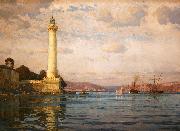 |
Michael Zeno Diemer -- Click Here
|
|
painted The Ahırkapı Lighthouse in 1906 - 1907
|
|
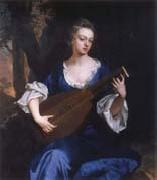 |
Michael Dahl -- Click Here
|
|
Swedish Baroque Era Painter, 1659-1743,Swedish painter, active in England. He studied under Martin Hannibal (d 1741) and later with David Kl?cker Ehrenstrahl. In 1682 he travelled to London, where he became acquainted with Godfrey Kneller and Henry Tilson, and in 1685 he left for Europe with the latter, working briefly in Paris before proceeding to Venice and Rome, where they stayed for about two years. In Rome Dahl converted to Roman Catholicism and gravitated towards the circle of Christina, former Queen of Sweden, who sat for him (Grimsthorpe Castle, Lincs). He returned to England with Tilson via Frankfurt and arrived in London in 1689; he stayed in England for the remainder of his career. |
|
|
|
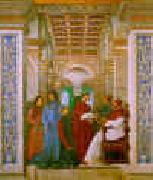 |
Melozzo da Forli -- Click Here
|
|
1438-1494
Italian
Melozzo da Forli Location
Melozzo came, it is supposed, of a wealthy family named Ambrosi from Forl??. Nothing is known about his early years, and it is only a hypothesis that he formed at the Forlivese school of art, then ruled by Ansuino da Forl??, for they were both influenced by the Mantegna manner.
It has been said that he became a journeyman and color-grinder to some of the best masters, in order to prosecute his studies; this lacks confirmation. His presence his first mentioned in his birthplace in 1460 and again in 1464. Around this period, together with Antoniazzo Romano, frescoed the Bessarione chapel in the basilica dei Santi Apostoli in Rome. Melozzo presumably moved to in Urbino between 1465 and 1475: here he met the highly theoretical and mathematical Piero della Francesca, who profoundly influenced the Melozzo style and use of perspective. He should have also studied the architectures by Bramante and other Flemish painters then working for the duke Federico da Montefeltro: perhaps Melozzo worked with Justus of Ghent and Pedro Berruguete to the decoration of the studiolo of the famous Ducal Palace of the city.
In 1475 Melozzo transferred to Rome, though some authorities claim his presence in Rome ten (or five) years earlier to work in the Basilica di San Marco. In 1477 he finished his first major work in the new seat, a fresco now transferred to canvas and placed in the Pinacoteca Vaticana, representing the appointment of Bartolomeo Platina by Sixtus IV as librarian of the restored Vatican Library. In 1478 he was one of the original members of the academy of St Luke, founded by Sixtus IV to unite the main painters working in the city.
About 1480 Melozzo was commissioned by Pietro Riario to paint the vault of the apse in the basilica dei Santi Apostoli in Rome, his subject being the Ascension. The figure of Christ is so boldly and effectively foreshortened that it seems to burst through the vaulting; this fresco was taken down in 1711, and the figure of Christ is now in the Quirinal Palace; while some of the other portions, almost Raphaelesque in merit, are in the sacristy of St Peter: a hall in the Vatican Museums is designed for angels and apostles by Melozzo taken down the same fresco. Another work of the Roman period is an Annunciation that can still be seen in the Pantheon.
Melozzo last work in Rome is a chapel, now destroyed, in the church of Santa Maria in Trastevere. After the death of Sixtus IV in 1484 he moved from Rome to Loreto. Here he painted the fresco in the cupola of San Marco sacristy in the basilica della Santa Casa, commissioned by cardinal Girolamo Basso della Rovere. It is one of the first examples of a cupola decorated both with architectures and figures, with a profound influence from the Camera Picta by Mantegna.
In 1489 Melozzo returned in Rome. In this second period he probably drew some cartoons for the mosaics of Jesus blessing in the St. Helen chapel of the basilica of Santa Croce in Gerusalemme.
Pope Sixtus IV appoints Bartolomeo Platina prefect of the Vatican Library, c. 1477 (fresco) (Vatican Museums)Melozzo also painted the cupola of the Capuchin church at Forl??, destroyed in 1651; and it has been said that he executed at Urbino some of the portraits of great men (Plato, Dante, Sixtus IV, etc.) which are now divided between the Barberini Palace and the Campana collection in Paris. In 1493 he worked to some ceilings of the Palazzo Comunale of Ancona, which have gone lost. Eventually Melozzo moved to Forl??, where, together with his pupil Marco Palmezzano, decorated the Feo Chapel in the church of San Biagio, which was destroyed during World War II. The Pinacoteca of Forl?? houses a fresco by Melozzo, termed the Pestapepe, or Pepper-grinder, originally painted as a grocer sign; it is an energetic specimen of rather coarse realism, now much damaged. It is the only non-religious subject by Melozzo. |
|
 |
Meliore di Jacopo -- Click Here
|
|
Italian, active ca.1260-1271
|
|
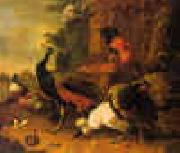 |
Melchior de Hondecoeter -- Click Here
|
|
1635-1695
Dutch
Melchior de Hondecoeter Gallery
Melchior d'Hondecoeter (c. 1636 ?C April 3, 1695), Dutch animalier painter, was born at Utrecht, and died in Amsterdam. After the start of his career, he painted virtually exclusively bird subjects, usually exotic or game, in a park-like landscapes.
Being the grandson of Gillis d'Hondecoeter and son of Gijsbert d'Hondecoeter, as well as nephew of Jan Baptist Weenix, he was brought up by the last to the profession of painting, when his father died. Of Weenix we know that he married Gilles daughter Josina in 1638. Melchior was, therefore, also related to Jan Weenix. The latter told Arnold Houbraken, in his youth Melchior was extremely religious, praying very loud, so his mother and uncle doubted if they would have him trained as a painter.
In 1659 he was working in the Hague and became a member of the painters' academy at the Hague. In 1663 Hondecoeter married Susanne Tradel in Amsterdam. While she was captious and having her sisters living in their house, Hondecoeter spent much time in his garden or drinking in the tavern in the Jordaan. On the Lauriergracht, where he used to live, he was surrounded by art dealers and various painters. Later he moved to a house on Prinsengracht. In 1686 he bought a small countryhouse in Vreeland. Hondecoeter died in the house of his daughter Isabel in Warmoesstraat but was buried in Westerkerk near his house. His inventory lists a small gallow, to keep birds in the right position, and several paintings of Frans Snyders.
Melchior began his career with a different speciality from that by which he is usually known. Mr de Stuers affirms that he produced sea-pieces. One of his earliest works is a "Tub with Fish," dated 1655, in the gallery of Brunswick. But Melchior soon abandoned fish for fowl. He acquired celebrity as a painter of birds only, which he represented not exclusively, like Johannes Fyt, as the gamekeeper's perquisite after a day's shooting, or stock of a poulterer's shop, but as living beings with passions, joys, fears and quarrels, to which naturalists will tell us that birds are subject. Without the brilliant tone and high finish of Fyt, his Dutch rival's birds are full of action; and, as Burger truly says, "Hondecoeter displays the maternity of the hen with as much tenderness and feeling as Raphael the maternity of Madonnas." |
|
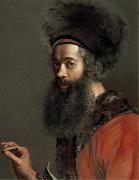 |
Maurice quentin de la tour -- Click Here
|
|
1704-88
French pastellist. He was one of the greatest pastellists of the 18th century, an equal of Jean-Sim?on Chardin and Jean-Baptiste Perronneau. Unlike them, however, he painted no works in oils. Reacting against the stately portraits of preceding generations and against the mythological portraits of many of his contemporaries, La Tour returned to a more realistic and sober style of work. The fundamental quality of his art lies in his ability to suggest the temperament and psychology of his subjects by means of their facial expression, and thereby to translate their fugitive emotions on to paper: 'I penetrate into the depths of my subjects without their knowing it, and capture them whole', as he himself put it. His considerable success led to commissions from the royal family, the court, the rich bourgeoisie and from literary, artistic and theatrical circles. |
|
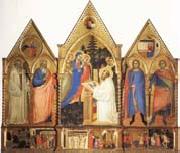 |
Matteo Di Pacino -- Click Here
|
|
Italian Byzantine Style Painter |
|
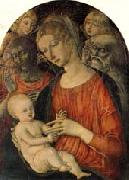 |
Matteo Di Giovanni -- Click Here
|
|
Italian Early Renaissance Painter, ca.1430-1495 |
|
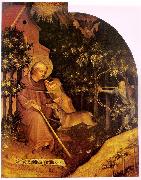 |
MASTER THOMAS de Coloswar -- Click Here
|
|
first half of 15th century |
|
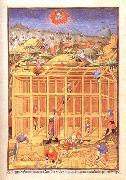 |
MASTER of the Duke of Bedford -- Click Here
|
|
French Early Renaissance Miniaturist, active 1405-1435 |
|
 |
master of St-Germain-des-Pres -- Click Here
|
|
originally from cologne active in Paris about 1500 |
|
|
|
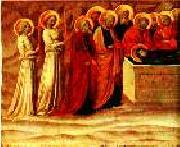 |
MASOLINO da Panicale -- Click Here
|
|
Italian Early Renaissance Painter, ca.1383-1447
Florentine painter of the early Renaissance, whose real name was Tommaso di Cristoforo Fini. His versatile painting incorporated his feeling for decorative color with strong modeling and spatial organization. He was admitted (1423) to the apothecaries' guild in Florence, in which painters were enrolled, and was soon commissioned to paint the frescoes in the Brancacci Chapel in Florence. These were continued by his pupil Masaccio upon Masolino's departure (1427) for Hungary and were completed by Filippino Lippi, thus greatly complicating the question of authorship; currently scholars attribute to Masolino St. Peter Preaching, St. Peter Healing the Cripple, The Raising of Tabitha, and The Fall of Adam and Eve. Upon his return to Florence, Masolino found painters occupied with problems of perspective, light and shade, and classical architecture and decoration, ideas that he utilized while retaining much of the old Giottesque tradition. He went to Rome where he painted frescoes in the Church of San Clemente for the Cardinal Branda Castiglione. For the same patron he decorated the church of Castiglione di Olona in the province of Como, Italy. There he represented scenes from the life of the Virgin and of St. John the Baptist. Attributed to Masolino are The Foundation of Santa Maria Maggiore and a Madonna and Christ in Glory (Naples); |
|
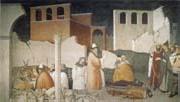 |
Maso di Banco -- Click Here
|
|
Italian Early Renaissance Painter, active 1320-1350 |
|
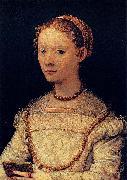 |
Maso da San Friano -- Click Here
|
|
(1536-1571) was an Italian painter active in Florence. His real name was Tomaso D'Antonio Manzuoli. He was born in San Friano and died in Florence.
According to Giorgio Vasari, Maso was a pupil of Pier Francesco Foschi while others claim it was Carlo Portelli. He collaborated with an elder Michelangelo on some projects.
His altarpiece of the Visitation was painted in 1560 for the church of San Pier Maggiore of Florence - now in Trinity Hall Chapel, Cambridge, England. A similar work can be seen in the Prato cathedral. After 1561, he painted in the church of Ognissanti, Florence and in the church of Santa Felicita. He participated in the decoration of the Studiolo of Francesco I with an oval canvas relating the Fall of Icarus story (1572). The canvas has an affected milling in individuals below and an anomalous perspective; both are classic features of mannerist painting. His second contribution Mining of Diamonds. A portrait of Ferdinando I de' Medici (1570) by Maso can be found in the Town Council Hall of Prato.
He is thought to be one of part of the Contra-Maniera or Counter-Mannerism movement in Florence. His most important pupils were Jacopo da Empoli and Alessandro Fei.
One of his paintings, thought to be of Cosimo I de Medici in 1560, is believed to be the oldest to show a watch
|
|
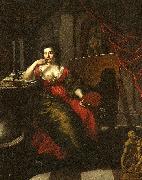 |
martin mijtens d.a -- Click Here
|
|
Martin Mijtens d.ä., Martin Meytens, Martin Mytens, född 1648 i Haag, Holland, död 1736 i Stockholm och begravd i Maria Kyrkan, nederländsk konstnär. Far till Martin Mijtens d.y. och son till porträttmålaren Isaac Mijtens.
Mijtens kom till Stockholm före eller under år 1677 och fann där ett så tacksamt fält för sin konst, att han beslöt stanna och 1681 satte han bo. Av hans första verk finns prov i Vibyholms och andra samlingar. De visar, att han hade en fin pensel, behaglig, varm, fastän tunn färg samt livlig och karakteristisk uppfattning av de skildrade. Med sina gråaktiga fonder, de ofta gulbruna draperierna och den enkla, naiva framställningen bildar Mijtens vid denna tid en bestämd motsats till David Klöcker Ehrenstrahl. Men dennes anseende och den gunst hans målningssätt vunnit var så stora, att även Mijtens måste böja sig. Så småningom blir hans bilder något anspråksfullare och djärvare, åtbörder och minspel kraftigare, bisakerna rikare, tonen i det hela mer högstämd, utan att personligheten försummas eller återgivningen av hudfärg överger den varma, åt gult dragande hållningen. Många bilder från denna hans andra period, som ungefär omfattar åren 1685- 1700, finns på Skoklosters slott, där Nils Bielke och hans grevinna, Eva Horn (i landskap), hör till mästarens bästa målningar, och på Vibyholm, i Uppsala (professor Schwedes porträtt i Uppsala museum och Olof Rudbeck d.ä.:s förträffliga bild, 1696, i medicinska fakultetens sessionsrum), i Hammers samling och på inte så få andra ställen. Konstnärens vana att högst sällan signera har gjort, att bilderna från dessa år ofta har blandats ihop med Ehrenstrahls och gått under den senares namn. Säkra skiljetecken är emellertid draperierna, som hos Mijtens saknar stil och ofta verkar tämligen slappt tecknade, och även det livligare åtbördsspelet. Man vet, att Mijtens, trots sin medtävlares anseende, var mycket eftersökt som porträttmålare och samlade förmögenhet på sin konst, så att han kunde bl.a. förvärva ett ej obetydligt konstgalleri. Han var även alltifrån 1692 och ganska länge kyrkoråd i den lilla holländska församlingen i Stockholm. 1697 och 1701 företog han resor till hembygden, den förra gången åtföljd av sin unge lärjunge Lucas von Breda. Utom denne ej obetydande konstnär utbildade Mijtens även sin son , som under det i Tyskland antagna namnet van Meytens berömde målaren (se denne), samt G. de Marees och möjligen flera. Man kan säga att omkring år 1700 vidtog Mijtens tredje maner. Karnationen får en dragning åt rött, som slutligen blir nästan stötande (t. ex. i Fabritius och prins Alexander av Georgiens porträtt på Gripsholms slott), teckningen vårdslösas mer, och de granna röda eller djupblå draperierna är stillösare och hårdare målade än förr. Dock lever ännu inte litet av den forna kraften i karaktärsteckningen, och anordningen bibehåller i mycket den förra prydligheten. Även denna hans nedgång finnes ej sällan företrädd i svenska samlingar. Märkligt är ett självporträtt (nu på Fånö i Uppland), emedan det enligt sägnen skall vara målat på hans höga ålderdom och under sinnessvaghet (om denna vet man för övrigt inget). Utom måleriet idkade han även gravyr samt utförde ett porträtt af Karl XI i svart maner och möjligen ett par andra blad i samma art (Gustaf Adolf de la Gardie, Georg Stiernhielm). Mijtens skall, enligt gammal uppgift, ha avlidit i Stockholm 1736; enligt en urkund levde han ännu i juli 1730. Hans målningssamling såldes av hans arvingar till preussiske överstemarskalken greve Gotter och kom inte långt därefter till storhertigen af Werttemberg. Carl Gustaf Tessin, som tycks ha hyst mycken ringaktning för Mijtens omtalar dock, att denna samling på sin tid ansågs som den enda framstående i riket (utom grefve Johan Gabriel Stenbocks). Att Carl Gustaf Tessin vid samma tillfälle kallar Mijtens "en gammal färgskämmare" och även annars talar illa om hans konst, tycks visa att Mijtens vid mitten af 1700-talet var fullkomligt bortglömd, åtminstone sådan han varit under sin bästa tid. Sedan finns han ej heller mycket omtalad. Först genom konstföreningens utställning 1841 och Nils Arfwidssons anmälan av honom i Frey återupptäcktes han; och man fann då, att Sverige i honom ägt en konstnär av sådan betydelse, att han kan mäta sig även med våra största mästare. Hans inflytande på den svenska konstens fortbildning blev dock ej särskilt stort. David Klöcker Ehrenstrahl och David von Krafft ställer honom i det avseendet fullkomligt i skuggan. |
|
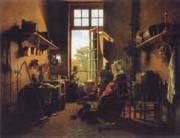 |
Martin Drolling -- Click Here
|
|
French Academic Painter, 1752-1817,After receiving initial training from an unknown painter in Selestat, Drolling moved to Paris, where he attended courses at the Acad?mie Royale. He supplemented his education there by studying Flemish and Dutch Old Masters in the collection at the Luxembourg Palace. From the Flemish school he derived his own rich impasto, while the Dutch was to influence him in his meticulous, supremely descriptive and unsentimental style of painting as well as his choice of subject-matter: unfussy bourgeois interiors and frank portraits. Drolling first exhibited at the Salon de la Correspondance in 1781 and again in 1782 and 1789. After the French Revolution he was able to participate in the Salon at the Louvre, despite the fact that he had never become a member of the Academie Royale. He exhibited from 1793 to 1817, although the majority of his works extant today were shown after 1800. From 1802 to 1813 he was employed by the Sevres porcelain manufactory, and many of his designs were engraved. |
|
 |
Martin Drolling -- Click Here
|
|
1752-1817
B.Oberbergheim
French Martin Drolling Art Gallery
After receiving initial training from an unknown painter in Selestat, Drolling moved to Paris, where he attended courses at the Academie Royale. He supplemented his education there by studying Flemish and Dutch Old Masters in the collection at the Luxembourg Palace. From the Flemish school he derived his own rich impasto, while the Dutch was to influence him in his meticulous, supremely descriptive and unsentimental style of painting as well as his choice of subject-matter: unfussy bourgeois interiors and frank portraits. Drolling first exhibited at the Salon de la Correspondance in 1781 and again in 1782 and 1789. After the French Revolution he was able to participate in the Salon at the Louvre, despite the fact that he had never become a member of the Academie Royale. He exhibited from 1793 to 1817, although the majority of his works extant today were shown after 1800. From 1802 to 1813 he was employed by the Sevres porcelain manufactory, and many of his designs were engraved. |
|
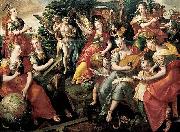 |
Marten de Vos -- Click Here
|
|
(1532-1603), also Maarten, was a leading Antwerp painter and draughtsman in the late sixteenth century.
|
|
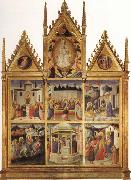 |
Mariotto Di Cristofano -- Click Here
|
|
San Giovanni Valdarno, 1393 - Firenze, 1457 |
|
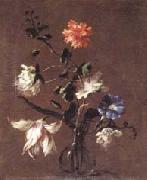 |
Mario Dei Fiori -- Click Here
|
|
Italian painter , Penna Fermana 1603- Rome 1673
Italian painter. He was the first and most famous Roman painter to specialize in flower-pieces and one of only four still-life artists included by Leone Pascoli in his collection of artists' biographies. The early sources and old inventories attribute many flower paintings in distinguished Roman collections to the Caravaggesque painter Tommaso Salini, and since the 18th century Mario's name has been linked with his, and it has been assumed that he trained with Salini. This apprenticeship is difficult to document, yet a comparison of Mario's pictures with inventory descriptions of works by Salini confirms that Mario was influenced by his art. To the minute observation of various kinds of flowers, Mario added a refined sense of design and an interest in effects of light, still linked to Caravaggio in the use of a dark background. |
|
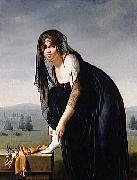 |
Marie-Denise Villers -- Click Here
|
|
(1774 - August 19, 1821) was a French painter, who specialized in portraits. She was born Marie-Denise Lemoine in Paris. She came from an artistic family, and her sisters Marie-Victoire Lemoine and Marie-Élisabeth Gabiou were also accomplished artists. In 1794, Marie-Denise married an architecture student, Michel-Jean-Maximilien Villers.
Villers was a student of the French painter Anne-Louis Girodet de Roussy-Trioson. She was first exhibited at the Paris Salon of the Year VII (1799). Villers' most famous painting, Young Woman Drawing, |
|
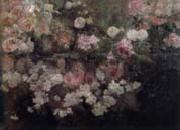 |
Maria Oakey Dewing -- Click Here
|
|
American Painter, 1845-1927 |
|
|
|
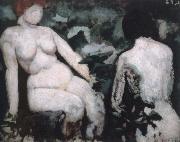 |
marcel duchamp -- Click Here
|
|
marche duchamp (1887 to 1968),French painter, sculptor and writer. The art and ideas of Duchamp, perhaps more than those of any other 20th-century artist, have served to exemplify the range of possibilities inherent in a more conceptual approach to the art-making process. Not only is his work of historical importance
|
|
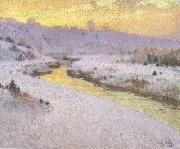 |
marc-aurele de foy suzor-cote -- Click Here
|
|
Canadian Painter, 1869-1937
was a Canadian painter and sculptor. He was born in Arthabaska, Quebec in 1869. He studied at the École des Beaux-Arts in Paris with L??on Bonnat during the 1890s. After his return to Quebec in 1908, he produced many impressionist paintings of the Quebec landscape, as well as portraits, nudes, historical paintings and later sculptures. |
|
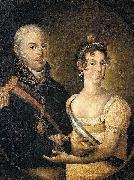 |
Manuel Dias de Oliveira -- Click Here
|
|
(1764 - 1837) |
|
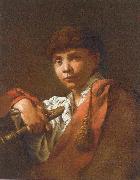 |
Maggiotto, Domenico -- Click Here
|
|
Italian Painter, 1713-1794 |
|
 |
Maclise, Daniel -- Click Here
|
|
Irish Painter, 1806-1870
Irish painter, active in England. He grew up in Cork where his father had set up as a shoemaker after discharge from the British army. In 1822 Maclise went to the Cork Institute where he began to draw from the newly arrived collection of casts made after the antique sculpture in the Vatican, laying the foundation of the strong draughtsmanship that characterizes his mature work. Richard Sainthill, antiquary and connoisseur, encouraged Maclise and introduced him to local literary and artistic circles, which were influenced by the Romantic movement and interested in Irish antiquities and oral traditions. Maclise was a central figure in this early phase of the Irish revival, and maintained an interest in Irish subject-matter throughout his career; in 1833 he painted Snap Apple (Mrs Cantor priv. col.), and in 1841 contributed illustrations to Samuel Carter Hall's Ireland: Its Scenery and Character. When Sir Walter Scott visited Cork in 1825, Maclise made a sketch of him that was lithographed, and that inaugurated his public career. |
|
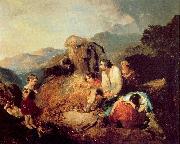 |
MacDonald, Daniel -- Click Here
|
|
Irish Painter, 1821-1853 |
|
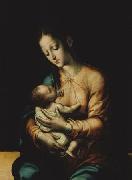 |
Luis de Morales -- Click Here
|
|
(1510 - 9 May 1586) was a Spanish painter born in Badajoz, Extremadura. Known as "El Divino", most of his work was of religious subjects, including many representations of the Madonna and Child and the Passion.
Influenced, especially in his early work, by Raphael Sanzio and the Lombard school of Leonardo, he was called by his contemporaries "The Divine Morales", because of his skill and the shocking realism of his paintings, and because of the spirituality transmitted by all his work.
His work has been divided by critics into two periods, an early stage under the influence of Florentine artists such as Michelangelo and a more intense, more anatomically correct later period similar to German and Flemish renaissance painters
|
|
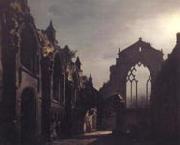 |
Luis Daguerre -- Click Here
|
|
French Painter , (1789-1851) |
|
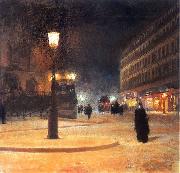 |
Ludwik de Laveaux -- Click Here
|
|
painted Parisian Opera at night. in 1892 - 1893
|
|
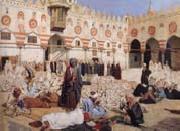 |
Ludwig Deutsch -- Click Here
|
|
Austrian-born French Academic Painter, 1855-1935 |
|
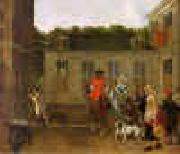 |
Ludolf de Jongh -- Click Here
|
|
1616-1679
Dutch
Ludolf de Jongh Galleries
Dutch painter. He was one of the most versatile Dutch painters of the 17th century, producing portraits, genre paintings of both domestic scenes and soldier life, landscapes with hunting scenes and a few historical subjects. According to Houbraken, he studied with Cornelis Saftleven in Rotterdam, Anthonie Palamedesz. in Delft, and Jan van Bijlert in Utrecht. In 1635 he went to France, where he stayed for seven years. His earliest known paintings are portraits and genre subjects that date from after his return to Rotterdam in about 1642 and strongly reflect the style of Palamedesz.'s work. The genre subjects and numerous hunting scenes (e.g. Riders before an Inn; Geneva, Mus. A. & Hist.) painted shortly before the 1650s show the influence of van Bijlert and other Utrecht painters, especially Jacob Duck and Dirck Stoop. |
|
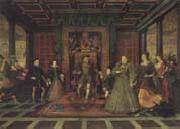 |
Lucas de Heere -- Click Here
|
|
1534-1584,Painter, tapestry designer, draughtsman and poet. He was probably trained by his parents. The suggestion that he became a member of the Ghent Guild of St Luke before 1540 was derived from an incorrect interpretation of the Guild records for 1574-5. Van Mander recorded that, as a boy, de Heere accompanied his father on his trips to the stone-quarries of the Meuse region, where he made topographical drawings. Lucas was sent to Frans Floris's studio c. 1555 or shortly before to complete his training, and he may have collaborated with his master on tapestry cartoons and stained-glass designs, although no cartoons or preparatory drawings survive. During this period de Heere also became noted as a poet in the local rhetoricians' chambers. His father's influence helped him to gain commissions in Ghent from 1555, and, according to Marcus van Vaernewijck (1568), he worked on new stained-glass windows for the St Janskerk in Ghent in the same year. |
|
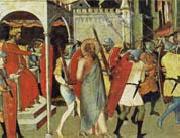 |
Luca di Tomme -- Click Here
|
|
Italian Painter, ca.1330-1390 |
|
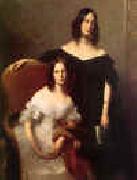 |
Louis-Edouard Dubufe -- Click Here
|
|
1819-1883 French
Son of Claude-Marie Dubufe. He was trained by his father and then by Paul Delaroche. He first appeared at the Salon in 1839 with the Annunciation, a Huntress and a portrait, winning a third class medal. He followed this in 1840 with an episode in the life of St Elisabeth of Hungary, which won him a second class medal; in 1844 he won a first class medal with Bathsheba and a genre scene set in the 15th century (all untraced). |
|
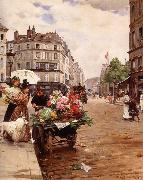 |
Louis Marie de Schryver -- Click Here
|
|
France
1862-1942
|
|
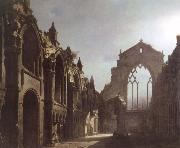 |
louis daguerre -- Click Here
|
|
Louis-Jacques-Mand?? Daguerre (November 18, 1787 ?C July 10, 1851) was a French artist and chemist, recognized for his invention of the daguerreotype process of photography.
Daguerre was born in Cormeilles-en-Parisis, Val-d'Oise, France. He apprenticed in architecture, theater design, and panoramic painting. Exceedingly adept at his skill for theatrical illusion, he became a celebrated designer for the theater and later came to invent the Diorama, which opened in Paris in July 1822.
In 1827, Joseph Nic??phore Ni??pce produced the world's first permanent photograph (known as a Heliograph). Daguerre partnered with Ni??pce two years later, beginning a four-year cooperation. Ni??pce died suddenly in 1833. The main reason for the "partnership", as far as Daguerre was concerned, was connected to his already famous dioramas. Niepce was a printer and his process was based on a faster way to produce printing plates. Daguerre thought that the process developed by Niepce could help speed up his diorama creation.
Daguerre announced the latest perfection of the Daguerreotype, after years of experimentation, in 1839, with the French Academy of Sciences announcing the process on January 7 of that year. Daguerre's patent was acquired by the French Government, and, on August 19, 1839, the French Government announced the invention was a gift "Free to the World."
Daguerre and Ni??pce's son obtained a pension from the Government in exchange for freely sharing the details of the process. Daguerre died in Bry-sur-Marne, 12 km from Paris. A monument marks his grave there.
|
|
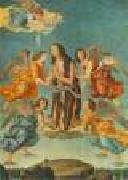 |
LORENZO DI CREDI -- Click Here
|
|
Italian High Renaissance Painter, ca.1458-1537 |
|
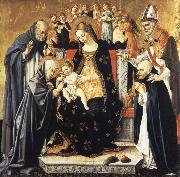 |
Lorenzo di Alessandro da Sanseverino -- Click Here
|
|
Italian Early Renaissance Painter, active 1468-1503 |
|
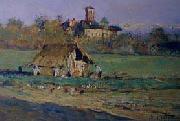 |
Lorenzo Delleani -- Click Here
|
|
(Pollone (Biella), 1840 - Turin, 1908) was an Italian painter.
A pupil of Cesare Gamba and Carlo Arienti at the Albertina Academy in Turin, Delleani worked initially in the field of history painting and received various marks of official recognition. He exhibited work at the Paris Salon of 1874 and gradually modernised his means of expression and range of subjects at the end of the decade with a new focus on landscape and painting from life. The early 1880s saw an exclusive focus on painting en plein air, capturing light in thick strokes of colour. His most frequent subjects were views of the Piedmontese and Lombard countryside in changing conditions of light and season. The artistes presentation of some 40 works at the Venice Biennale in 1905 and participation in the International Exhibition in Munich of the same year set the seal on his international success.
|
|
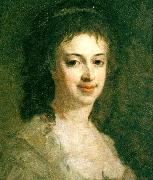 |
lorens pasch d.y -- Click Here
|
|
Lorens Pasch d.y., född 1733, död 1805, konstnär; professor vid Konstakademien från 1773. Son till Lorens Pasch d.ä., bror till Ulrika Pasch, brorsson till Johan Pasch. Invald tillsammans med sin syster i Konstakademien 1773. |
|
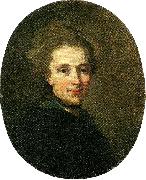 |
lorens pasch d. y -- Click Here
|
|
Lorens Pasch d.y., född 1733, död 1805, konstnär; professor vid Konstakademien från 1773. Son till Lorens Pasch d.ä., bror till Ulrika Pasch, brorsson till Johan Pasch. Invald tillsammans med sin syster i Konstakademien 1773. |
|
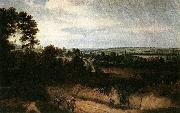 |
Lodewijk de Vadder -- Click Here
|
|
Lodewijk de Vadder (1605, Grimbergen - 1655, Brussels) was a Flemish Baroque landscape painter and engraver.
He became a master of Antwerp's Guild of St. Luke in 1628, and learned painting from his father and brothers. He specialized in landscapes with woods, in the manner of his contemporary Jacques d'Arthois and his pupil Lucas Achtschellinck[1]. They are usually referred to collectively as "The Sonian Forest Painters". |
|
|
|
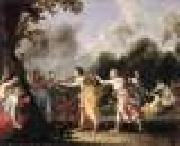 |
LISSE, Dirck van der -- Click Here
|
|
Dutch painter (b. 1607, Den Haag, d. 1669, Den Haag) |
|
 |
Liberale da verona -- Click Here
|
|
Italian Early Renaissance Painter,
ca.1445-1530 |
|
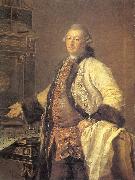 |
Levitsky, Dmitry -- Click Here
|
|
Russian Painter, 1735-1822
.Russian painter of Ukrainian birth. Together with Fyodor Rokotov and Vladimir Borovikovsky, he ranks foremost among 18th-century Russian portrait painters. He received his first lessons in painting from his father, Grigory Levitsky-Nos (1697-1769), a priest, engraver and painter. He also studied under Aleksey Antropov, who had come to Kiev to decorate St Andrew's church (1752-5). In the late 1750s Levitsky went with Antropov to St Petersburg, where he stayed until 1764; he continued with lessons from Antropov to whom, it appears, he owed the objectivity that was to characterize his work. It is probable that he also studied at the St Petersburg Academy of Arts, attending classes under Louis Lagren?e. Levitsky worked with Antropov on the decoration of triumphal arches in Moscow for Catherine II's coronation in 1762. His first known portraits are rather formal, for example that of the architect Aleksandr Kokorinov (1769; St Petersburg, Rus. Mus.), which won Levitsky the title of Academician in 1770. In such works he made successful use of a compositional structure typical of formal European portrait painting, intended to emphasize the importance of the sitter. |
|
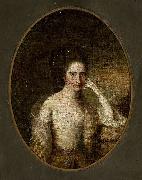 |
Leonor de Almeida Portugal -- Click Here
|
|
Leonor de Almeida Portugal de Lorena e Lencastre (Lisboa, 31 de outubro de 1750 - Benfica, 11 de outubro de 1839) foi uma nobre e poetisa portuguesa. |
|
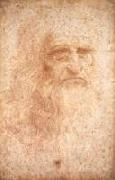 |
LEONARDO da Vinci -- Click Here
|
|
Italian High Renaissance Painter and Inventor, 1452-1519
Italian High Renaissance Painter and Inventor, 1452-1519 Florentine Renaissance man, genius, artist in all media, architect, military engineer. Possibly the most brilliantly creative man in European history, he advertised himself, first of all, as a military engineer. In a famous letter dated about 1481 to Ludovico Sforza, of which a copy survives in the Codice Atlantico in Milan, Leonardo asks for employment in that capacity. He had plans for bridges, very light and strong, and plans for destroying those of the enemy. He knew how to cut off water to besieged fortifications, and how to construct bridges, mantlets, scaling ladders, and other instruments. He designed cannon, very convenient and easy of transport, designed to fire small stones, almost in the manner of hail??grape- or case-shot (see ammunition, artillery). He offered cannon of very beautiful and useful shapes, quite different from those in common use and, where it is not possible to employ cannon ?? catapults, mangonels and trabocchi and other engines of wonderful efficacy not in general use. And he said he made armoured cars, safe and unassailable, which will enter the serried ranks of the enemy with their artillery ?? and behind them the infantry will be able to follow quite unharmed, and without any opposition. He also offered to design ships which can resist the fire of all the heaviest cannon, and powder and smoke. The large number of surviving drawings and notes on military art show that Leonardo claims were not without foundation, although most date from after the Sforza letter. Most of the drawings, including giant crossbows (see bows), appear to be improvements on existing machines rather than new inventions. One exception is the drawing of a tank dating from 1485-8 now in the British Museum??a flattened cone, propelled from inside by crankshafts, firing guns. Another design in the British Museum, for a machine with scythes revolving in the horizontal plane, dismembering bodies as it goes, is gruesomely fanciful. Most of the other drawings are in the Codice Atlantico in Milan but some are in the Royal Libraries at Windsor and Turin, in Venice, or the Louvre and the École des Beaux Arts in Paris. Two ingenious machines for continuously firing arrows, machine-gun style, powered by a treadmill are shown in the Codice Atlantico. A number of other sketches of bridges, water pumps, and canals could be for military or civil purposes: dual use technology. Leonardo lived at a time when the first artillery fortifications were appearing and the Codice Atlantico contains sketches of ingenious fortifications combining bastions, round towers, and truncated cones. Models constructed from the drawings and photographed in Calvi works reveal forts which would have looked strikingly modern in the 19th century, and might even feature in science fiction films today. On 18 August 1502 Cesare Borgia appointed Leonardo as his Military Engineer General, although no known building by Leonardo exists. Leonardo was also fascinated by flight. Thirteen pages with drawings for man-powered aeroplanes survive and there is one design for a helicoidal helicopter. Leonardo later realized the inadequacy of the power a man could generate and turned his attention to aerofoils. Had his enormous abilities been concentrated on one thing, he might have invented the modern glider. |
|
 |
Leonardo Da Vinci -- Click Here
|
|
Italian High Renaissance Painter and Inventor, 1452-1519
Florentine Renaissance man, genius, artist in all media, architect, military engineer. Possibly the most brilliantly creative man in European history, he advertised himself, first of all, as a military engineer. In a famous letter dated about 1481 to Ludovico Sforza, of which a copy survives in the Codice Atlantico in Milan, Leonardo asks for employment in that capacity. He had plans for bridges, very light and strong, and plans for destroying those of the enemy. He knew how to cut off water to besieged fortifications, and how to construct bridges, mantlets, scaling ladders, and other instruments. He designed cannon, very convenient and easy of transport, designed to fire small stones, almost in the manner of hail??grape- or case-shot (see ammunition, artillery). He offered cannon of very beautiful and useful shapes, quite different from those in common use and, where it is not possible to employ cannon ?? catapults, mangonels and trabocchi and other engines of wonderful efficacy not in general use. And he said he made armoured cars, safe and unassailable, which will enter the serried ranks of the enemy with their artillery ?? and behind them the infantry will be able to follow quite unharmed, and without any opposition. He also offered to design ships which can resist the fire of all the heaviest cannon, and powder and smoke.
The large number of surviving drawings and notes on military art show that Leonardo claims were not without foundation, although most date from after the Sforza letter. Most of the drawings, including giant crossbows (see bows), appear to be improvements on existing machines rather than new inventions. One exception is the drawing of a tank dating from 1485-8 now in the British Museum??a flattened cone, propelled from inside by crankshafts, firing guns. Another design in the British Museum, for a machine with scythes revolving in the horizontal plane, dismembering bodies as it goes, is gruesomely fanciful.
Most of the other drawings are in the Codice Atlantico in Milan but some are in the Royal Libraries at Windsor and Turin, in Venice, or the Louvre and the École des Beaux Arts in Paris. Two ingenious machines for continuously firing arrows, machine-gun style, powered by a treadmill are shown in the Codice Atlantico. A number of other sketches of bridges, water pumps, and canals could be for military or civil purposes: dual use technology.
Leonardo lived at a time when the first artillery fortifications were appearing and the Codice Atlantico contains sketches of ingenious fortifications combining bastions, round towers, and truncated cones. Models constructed from the drawings and photographed in Calvi works reveal forts which would have looked strikingly modern in the 19th century, and might even feature in science fiction films today. On 18 August 1502 Cesare Borgia appointed Leonardo as his Military Engineer General, although no known building by Leonardo exists.
Leonardo was also fascinated by flight. Thirteen pages with drawings for man-powered aeroplanes survive and there is one design for a helicoidal helicopter. Leonardo later realized the inadequacy of the power a man could generate and turned his attention to aerofoils. Had his enormous abilities been concentrated on one thing, he might have invented the modern glider. |
|
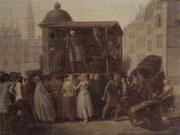 |
Leonard Defrance -- Click Here
|
|
Flemish Painter, 1735-1805 |
|
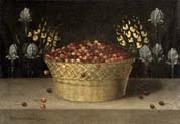 |
LEDESMA, Blas de -- Click Here
|
|
Spanish painter documented 1602-1614 in Granada,Spanish painter. He is known to have worked in Granada from 1602, and in 1614 he designed a stucco vault decoration for the Alhambra. Archival sources testify to his renown as a painter of decorative fresco grotesques (untraced) and still-lifes. His activity as a still-life painter remains debatable, partly because he has been confused with Blas de Prado and also because of Torres Marten's controversial attributions. Ledesma's only unanimously accepted autograph painting is Still-life with Cherries and Flowers (Atlanta, GA, High Mus. A.), signed in Granada. A highly decorative painting, it shows none of the sophistication of still-lifes by Juan Senchez Cot?n, in Granada from 1603. It is painted meticulously and drily. Depicting a severely drawn, rather flat basket on a narrow ledge flanked by flowers behind it, the rigorously symmetrical composition is relieved only by soft lighting and the studied disarray of some fallen cherries. Two other unsigned and poorly preserved still-lifes of analogous subject-matter have been attributed to Ledesma |
|
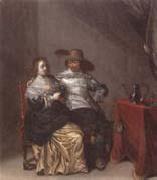 |
Laurentius de Neter -- Click Here
|
|
German , Born in Elbing circa 1600-1649
|
|
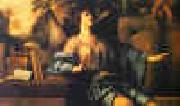 |
Laurent de la Hyre -- Click Here
|
|
1606-1656
French Laurent de la Hyre Galleries
He became a pupil of Georges Lallemand and studied the works of Primaticcio at Fontainebleau, but never visited Italy. La Hyre is associated with the transitional period before the introduction of the French Baroque by Simon Vouet.
His picture of Pope Nicholas V opening the crypt in which he discovers the corpse of St. Francis of Assisi standing (located at the Louvre) was executed in 1630 for the Capuchin friars of the Marais; its gravity and sobriety seems to have been influential for the next generation of French painters, particularly Eustache Le Sueur. The Louvre contains eight other works, and paintings by La Hyre are in the museums of Strasburg, Rouen and Le Mans.
Laurent de La Hyre: Perspective (drawing).His drawings, of which the British Museum possesses a fine example, Presentation of the Virgin in the Temple, are treated as seriously as his paintings, and sometimes show simplicity and dignity of effect. The example of the Capuchins, for whom he executed several other works in Paris, Rouen and Fecamp, was followed by the goldsmith's company, for whom he produced in 1635 St. Peter healing the Sick (Louvre) and the Conversion of St Paul in 1637. In 1646, with eleven other artists, he founded the French Royal Academy of Painting and Sculpture.
Richelieu called La Hyre to the Palais Royal; Pierre S??guier, Gedeon Tallemant des R??aux and many others entrusted him with important works of decoration; for the Gobelins he designed a series of large compositions. La Hyre painted also a great number of portraits, and in 1654 united in one work for the town-hall of Paris those of the principal dignitaries of the municipality. |
|
 |
Lajos Deak-ebner -- Click Here
|
|
(1850- 1934 ) - Painter
painted On the Road in between 1876(1876) and 1880(1880)
|
|
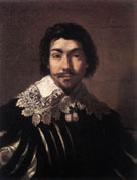 |
L ESTIN, Jacques de -- Click Here
|
|
French painter ,
b. 1597, Troyes, d. 1661, Troyes |
|
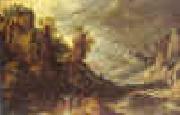 |
Kerstiaen de Keuninck -- Click Here
|
|
1560-1635
Flemish
Kerstiaen de Keuninck Gallery
Flemish painter. Although from Courtrai, from an early age he lived in Antwerp. He was listed in 1577 as one of the recipients of the Poor-box (armenbus) of the Antwerp Guild of St Luke, where he was received as master in 1580. He married in 1585. De Keuninck took on Carel de Ferrara as an apprentice in 1599. His son Kerstiaen de Keuninck the younger (d 1642-3) became a master in 1613. In 1629 Engel Ergo started an apprenticeship with a Kerstiaen de Keuninck: it is not clear whether this refers to father or son. |
|
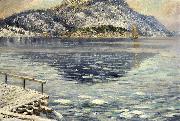 |
Karl Edvard Diriks -- Click Here
|
|
Norway (1855 -1930 ) - Painter
|
|
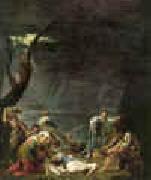 |
Karel Dujardin -- Click Here
|
|
1621-1678
Dutch
Karel Dujardin Locations
Dujardin was born in Amsterdam in 1640. After training with Nicolaes Berchem, he went to Italy when young, and became a member of the Society of Painters at Rome, among whom, he was known as Barba di Becco. In Rome, his works met with general approbation.
According to some sources, on his way back to his native country, he contracted considerable debts at Lyon, to free himself from which, he married his old and rich landlady. He went with her to Amsterdam, where his pictures were valued very highly. He soon secretly left his home in that city, probably from dislike of his wife, and went back to Rome in 1675, where he was welcomed by his old friends and admirers, and lived at great expense. After a vist to Tangier he went to Venice, where he died in 1678.
Most of his paintings are cabinet paintings of Italianate landscapes and or with farm animals and peasants. His landscapes have spirit and harmony, his figures expression, and his colour the brilliancy which distinguishes his school. His paintings are rare and command a high price. He also published fifty-two etchings of simiar subjects, with great spirit and ease.
He painted a single, fine, portrait (probably a self-portrait), and a pair of Baroque religious paintings on the life of St Paul, probably commissioned, as they lie well outside his normal style. One of these, and the portrait, are in the National Gallery, London |
|
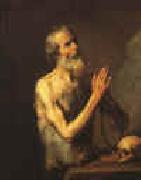 |
Jusepe de Ribera -- Click Here
|
|
1591-1652
Spanish
Jusepe de Ribera Galleries
Jusepe de Ribera (January 12, 1591 - 1652) was a Spanish Tenebrist painter and printmaker, also known as Jos?? de Ribera in Spanish and as Giuseppe Ribera in Italian. He was also called by his contemporaries and early writers Lo Spagnoletto, or "the Little Spaniard". Ribera was a leading painter of the Spanish school, although his mature work was all done in Italy.
In his earlier style, founded sometimes on Caravaggio and sometimes on the wholly diverse method of Correggio, the study of Spanish and Venetian masters can be traced. Along with his massive and predominating shadows, he retained from first to last a great strength in local coloring. His forms, though ordinary and sometimes coarse, are correct; the impression of his works gloomy and startling. He delighted in subjects of horror. In the early 1630s his style changed away from strong contrasts of dark and light to a more diffused and golden lighting. Salvator Rosa and Luca Giordano were his most distinguished followers, who may have been his pupils; others were also Giovanni Do, Enrico Fiammingo, Michelangelo Fracanzani, and Aniello Falcone, who was the first considerable painter of battle-pieces.
Among Ribera's principal works could be named "St Januarius Emerging from the Furnace" in the cathedral of Naples; the "Descent from the Cross" in the Certosa, Naples, the "Adoration of the Shepherds" (a late work, 1650), now in the Louvre; the "Martyrdom of St Bartholomew" in the Prado; and the "Pieta" in the sacristy of San Martino, Naples. His mythologic subjects are often as violent as his martyrdoms: for example, "Apollo and Marsyas", with versions in Brussels and Naples, or the "Tityus" in the Prado . The Prado and Louvre contain numbers of his paintings; the National Gallery, London, three. He executed several fine male portraits and a self-portrait. He was an important etcher, the most significant Spanish printmaker before Goya, producing about forty prints, nearly all in the 1620s. |
|
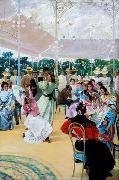 |
Julio Romero de Torres -- Click Here
|
|
was a Spanish painter.
He was born and died in Cerdoba, Spain, where he lived most of his life. His father was the famous painter Rafael Romero Barros and his mother was Rosario de Torres Delgado. Julio learned about art from his father who was the director, curator and founder of Cerdoba's Museo Provincial de Bellas Artes and an impressionist painter. He took an interest in art at a young age and started studying at the School of Fine Arts when he was 10. He went to Madrid to work and study in 1906. He also traveled all over Europe to study and he picked up a symbolist style, for which he is best known. A museum dedicated to the work of de Torres is situated at Plaza del Potro 1 Cordoba 14002.
He spent most of his life living in Cerdoba and Madrid and both places had influences on his paintings. He combined many different styles when he painted because he had many different influences including realism, which was a popular style at that time and impressionism, which he picked up from living in Cerdoba and from his father. While in Cerdoba he became part of the late 19th century intellectual movement that was based on the Royal Academy of Science, Arts and Literature. Julio Romero also won many awards in his lifetime. In 1895 he won an honorable mention at the National Exhibition and later won third place in 1899 and 1904.
El Retablo del Amor by Julio Romero de Torres, painted in 1910.In 1914 he relocates to Madrid, where he makes contact with the intellectual and artistic environment of the time together with his brother Enrique. He became a regular at the cafe Nuevo Levante and his paintings began to reflect the philosophical currents of the times, represented by such writers of the times as Ramen del Valle-Inclen and Ruben Dareo. When the war broke out in 1914 Julio Romero fought for the allies as a pilot
|
|
 |
Julien Dupre -- Click Here
|
|
1851-1910
French
Julien Dupre Location |
|
 |
julian alden weir -- Click Here
|
|
American Impressionist Painter, 1852-1919
.American painter. He studied with his father Robert Walter Weir, a landscape painter of the Hudson River school, at the National Academy; and with Görôme in Paris. He was one of the earliest American impressionist painters. Subtle gradations of light and tone characterize his work. He was a founder of the Society of American Artists (1877), a member of the National Academy (1886), and its president (1915 C17). When the Ten American Artists formed a separate group (1898), he joined them. His works include Idle Hours, The Green Bodice, and The Red Bridge; a portrait and Autumn ; and Midday Rest in New England. |
|
 |
Jules-elie delaunay -- Click Here
|
|
French Neoclassical Painter, 1828-1891 |
|
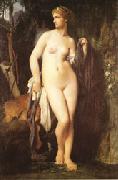 |
Jules Elie Delaunay -- Click Here
|
|
Nantes 1828 - Paris 1891.
French Neoclassical Painter.
Studied under Hippolyte Flandrin.
French Neoclassical Painter. Studied under Hippolyte Flandrin. French painter. He entered the Ecole des Beaux-Arts in Paris on 7 April 1848, where he was a pupil of Joachim Sotta (1810-77), Hippolyte Flandrin and Louis Lamothe (1822-69). He became a disciple of Flandrin, and, though making his debut in the Salon in 1853 with the Saltworkers of Guerande (Nantes, Mus. B.-A.), he soon concentrated on history painting. In 1856 he won the Prix de Rome with the Return of the Young Tobias (Paris, Ecole N. Sup. B.-A.) and left Paris to study at the Academie de France in Rome. His work is imbued with a deep religious sentiment cast in the restrained, controlled style and formal repertoire of Neo-classicism. From early in his career he produced many easel and wall paintings on religious subjects, such as Jesus Healing the Lepers (1850; Le Croisic,). In 1854 he received a commission to produce four fresco decorations for the church of the monastery of the Visitation-Ste-Marie in Nantes, which he completed the following year. In 1865 he returned to the monastery to decorate the chapel of St-Francois de Sales with scenes from that saint's life. |
|
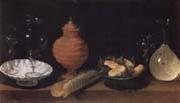 |
Juan van der Hamen y Leon -- Click Here
|
|
Spanish Baroque Era Painter, 1596-1631, was a Spanish painter, a master of the still life paintings, also called bodegones. During his lifetime, he was prolific and versatile, painting allegories, landscapes, and large-scale works for churches and convents. However, today he is remembered mostly for his still lifes. In the 1620s, He popularized still life painting in Madrid.Juan van der Hamen y (Gemez de) Leen was born in Madrid in 1596 but he was baptized late on April 8, 1596 in Madrid, therefore, he must had been born there just days before that date. He was the son of Jehan van der Hamen, a Flemish courtier, who had moved to Madrid from Brussels before 1586, and Dorotea Whitman Gemez de Leen, a half-Flemish mother of noble Toledan ancestry [1]. Van der Hamen and his two brothers Pedro and Lorenzo (both of whom were writers) emphasized their Spanish roots by using all or part of their maternal grandmother's family name, Gemez de Leen.. The painter's father, Jan van der Hamen, had come to Spain, as an archer, to the court of Philip II were he settled, married, and his children were born. According to 18th-century sources, the artist's father had also been a painter, but there is no evidence for this. Juan van der Hamen inherited his father's honorary positions at court and also served as unsalaried painter of the king. Van der Hamen's artistic activity in the service of the crown is first recorded on 10 September 1619, when he was paid for painting a still-life for the country palace of El Pardo, to the north of Madrid. |
|
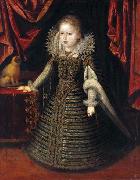 |
Juan Pantoja de la Cruz -- Click Here
|
|
(Valladolid, 1553 - 26 October 1608, Madrid) Spanish painter, one of the best representatives of the Spanish school of court painters. He worked for Philip II and Philip III. The Museo del Prado contains examples of his severe portraiture style.
Juan Pantoja de La Cruz was, born 1553 in Valladolid. Very little is known of his formative years as a painter. He was a pupil of the court painter Alonso Senchez Coello in Madrid and he must have assisted his master in complying with his duties as painter of the Spanish King, Philip II. Pantoja probably continued to work in his master studio after completing his training. He married in 1585 beginning to paint for the court around that time. After Sanchez Coello's death in 1588, Pantoja took over his master workshop and became court painter to Philip II of Spain.
Pantoja kept working for the court and the nobility, painting portraits of Prince Philip, the future Philip III, in 1592 and 1594. Among his most well known works is the portrait of Philip II wearing a cape and hat all in black, painted around 1594 for the Escorial. This portrait is one of the best representations of the idea of Spanish majesty, based on the remoteness of the monarch. On Philip II's death in 1598, Philip III confirmed Pantoja's status as court painter. When the court settled in Valladolid in 1601, Pantoja moved to the new capital, remaining in this city, several years. |
|
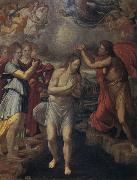 |
Juan Fernandez de Navarrete -- Click Here
|
|
Spanish painter
1526-1579
was a Spanish Mannerist painter, born at Logroño. An illness in infancy deprived Navarrete of his hearing, but at a very early age he began to express his wants by sketching objects with a piece of charcoal. He received his first instructions in art from Fray Vicente de Santo Domingo, a Hieronymite monk at Estella, and also with Becerra. He visited Naples, Rome, Florence and Milan. Pellegrino Tibaldi met him in Rome in 1550. According to most accounts he was for a considerable time the pupil and assistant of Titian at Venice. In 1568 Philip II of Spain summoned him to Madrid with the title of king's painter and a salary, and employed him to execute pictures for the Escorial. During the 1560s and 1570s the huge monastery-palace of El Escorial was still under construction and Philip II was experiencing difficulties in finding good artists for the many large paintings required to decorate it. Titian was very old, and died in 1576, and Tintoretto, Veronese and Anthonis Mor all refused to come to Spain. Philip had to rely on the lesser talent of Navarrete, whose gravedad y decoro ("seriousness and decorum") the king approved. For eleven years until his death Navarrete worked largely on El Escorial. The most celebrated of the works he produced there are a "Nativity" (in which, as in the well-known work on the same subject by Correggio, the light emanates from the infant Saviour), a "Baptism of Christ" (now Prado), and "Abraham Receiving the Three Angels" (one of his last works, dated 1576). |
|
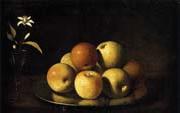 |
Juan de Zurbaran -- Click Here
|
|
Spanish Baroque Era Painter, 1620-1649 |
|
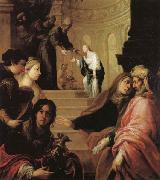 |
Juan de Sevilla romero -- Click Here
|
|
Spanish , 1643-1695
|
|
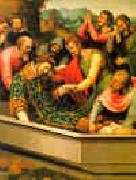 |
Juan de Juanes -- Click Here
|
|
1523-1579
Spanish
Juan de Juanes Gallery
Born in Bocairent and was considered the premier painter of the Valencian school of painters, and often called "the Spanish Raphael", was born at La Font de la Figuera in the province of Valencia. He is said to have studied his art for some time in Rome, with which school his affinities are closest, but he greater part of his professional life was spent in the city of Valencia, where most of the extant examples of his work are now to be found. All relate to religious subjects, and are characterized by dignity of conception, accuracy of drawing, ruth and beauty of color, and minuteness of finish. He died at Bocairent (near X??tiva) while engaged upon an altarpiece in the church there.
Since his name Macip made him sound like a laborer (macero), he adopted the name of Juanes or de Juan, and the heraldy of that family of nobility. He painted a Raphaelesqe Holy Family for the sacristy in the Cathedral of Valencia. He never painted a profane subject, and emulated Luis de Cargas and Fra Angelico de Fiesole, in never painting unless he had underwent holy communion. Painting for him was a solemn exercise, an oratory process, full of prayers and fasts. He never lacked church patronage; the archbishop of Valencia, St. Thomas of Villanova, ordered a set of cartoon panels about the Life of the Virgin to model for some tapestries. He also painted for the churches of the Jesuits, Domicans, Minims, Augustinians, Franciscans, and for the churches of San Nicol??s , Santa Cruz , Carmen Calzado, St Esteban, Corona, Temple, San Andr??s, San Bartolom?? and San Miguel de los Reyes. Among his best works is the Immaculate Conception painted for the Jesuit church, supposedly inspired by a revelation undergone by the painter's confessor, Father Martin Alberto, confesor del pintor. Macip also painted portraits. His son, Juan Vicente Joanes, imitated his style. His two daughters, Dorotea and Margarita were also painters. Him most prominent pupil was Nicolas Borras.
|
|
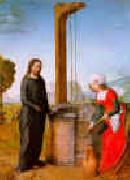 |
Juan de Flandes -- Click Here
|
|
Flemish-born Spanish Northern Renaissance Painter, ca.1460-1519
South Netherlandish painter, active in Spain. Nothing is known of his life or work before he went to Spain, where he is first mentioned in a document of 1496 as Juan de Flandes, a painter in the service of Queen Isabella of Castile. Treasury accounts confirm that he held this position until the Queen death in 1504. On arriving in Spain, he must have lived in Burgos, where he certainly met MICHEL SITTOW, another painter in the Queen service, who had been at the Castilian court since 1492. |
|
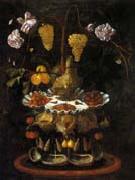 |
Juan de Espinosa -- Click Here
|
|
Spanish Baroque Era Painter, ca.1590-1641, Spanish painter. Details of his life are scarce. He is documented in Madrid and Toledo between 1612 and 1626, and while he is recorded as having painted religious pictures and portraits (untraced), he is only known today for his still-life paintings. Documents relating to another artist of the same name, known as Juan de Espinosa, dating from 1645 to 1677, concern a different painter. |
|
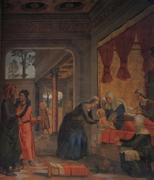 |
Juan de Borgona -- Click Here
|
|
Spanish Painter,
ca.1470-1534
was a High Renaissance painter who was born in the Duchy of Burgundy, probably just before it ceased to exist as an independent state, and was active in Spain from about 1495 to 1534. His earliest documented work was painted in 1495 for the cloister of the Cathedral of Toledo. Borgoña??s compositions are well balanced with finely drawn figures in elegant, tranquil poses. They are set either against open spaces leading on to craggy landscapes or against gold embroidered drapery. There were a number of foreign painters active in Spain in this period, including Juan de Flandes. Borgona??s students include Pedro de Cisneros the Elder (died 1546), Antonio de Comontes (ca. 1500-1519), |
|
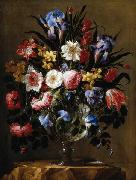 |
Juan de Arellano -- Click Here
|
|
(3 August 1701 - 13 October 1776) was a Spanish painter of the Baroque era who specialized in floral still life paintings.
Born in Santorcaz, near Madrid, where he died. He was a pupil of Juan de Solis. Heavily influenced by Flemish and Italian painters (such as Mario Nuzzi), Juan de Arellano was considered to be exceptional in this thematic. According to one of his colleagues, de Arellano decided to focus exclusively on floral paintings because it offered more pay while requiring less work . Some of de Arellano's most famous pieces include Bouquet of Flowers (c.1660), and Garland of Flowers, Birds and Butterfly, currently on display at the Louvre. He also painted for the sacristy of the church of San Jerenimo el Real of Madrid. See Bodegen for a description of one style of Spanish still life painting. |
|
 |
Juan de Espinosa -- Click Here
|
|
Spanish Baroque Era Painter, ca.1590-1641
Spanish painter. Details of his life are scarce. He is documented in Madrid and Toledo between 1612 and 1626, and while he is recorded as having painted religious pictures and portraits (untraced), he is only known today for his still-life paintings. Documents relating to another artist of the same name, known as Juan de Espinosa, dating from 1645 to 1677, concern a different painter. |
|
|
|
|
| | |
|
|
|
|